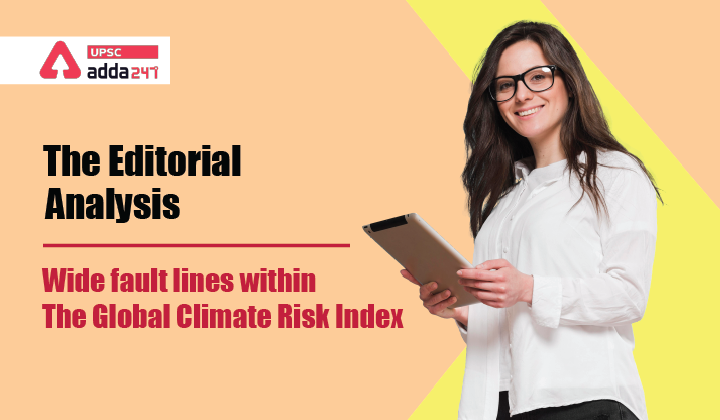Table of Contents
Global Climate Risk Index: Relevance
- GS 3: Conservation, environmental pollution and degradation, environmental impact assessment.
Effective methods to manage climate change are needed
- In the recently help COP26 in Glaslow, Scotland, the address by the Prime Minister of Barbados has garnered a lot of attention.
- She exclaimed that failure to provide critical adaptation finance as well as measuring the extent of loss caused by climate change with respect to “lives and livelihoods” was immoral.
- The Intergovernmental Panel on Climate Change (IPCC) defines climate risk as the likelihood of unfavourable impacts that occur when severe climate events interact with vulnerable environmental, social, economic, political or cultural
- Quantitatively, it is the product of the probability of a climate event occurring and its adverse consequences.
Global Climate Risk Index
- The latest version of the Global Climate Risk Index (GCRI), published annually by GermanWatch, ranked 180 countries based on the impact of extreme weather events and associated socio-economic data from 2000-2019.
- According to the GermanWatch, the rankings are meant to forewarn countries about the possibility of more frequent and/or severe climate-related events in the future.
- This index uses historical data to provide insights on exposure to extreme events. It, however, cannot be used for linear forecasts about future climate impact.
GCRI fault lines
- First, the GCRI ranks countries based on four key indicators:
- number of deaths;
- number of deaths per 1,00,000 inhabitants;
- sum of losses in Purchasing Power Parity (in U.S. dollars);
- and losses per unit of the Gross Domestic Product (GDP).
- Of these indicators, two are absolute while the other two are relative.
- However, the GCRI report does not provide a rationale for the selection of these macro indicators.
- Second, the index suffers from exclusion errors and selection bias.
- Composite indicators are better constructed using micro indicators instead of macro indicators, which measure loss because isolating the effect of the loss of elements on GDP is fraught with errors.
- Instead, a number of key micro indicators such as the total number of people injured, loss of livestock, loss of public and private infrastructure, crop loss and others are better candidates for assessing the composite loss resulting from climate change events.
- Third, the index accounts for information on weather-related events like storms, floods, temperature extremes and mass movements.
- However, it omits geological incidents like earthquakes, volcanic eruptions or tsunamis, which may be potentially triggered by climate change and can have economic and humanitarian impact.
- Fourth, the ranking under the GCRI is done based on data collected by Munich Re’s NatCatService, which is not validated at the ground-level.
- The data gaps with regard to economic losses are based on experience, the prevailing intellectual property of MunichRe and the market value of elements at risk that are at best approximate values of economic losses.
Delays in action and response
- Any discussion on measurement and management of climate risk is incomplete without accounting for issues of uncertainty, scale and delays between action and response to climate change.
- Therefore, climate change can at best be managed within a comprehensive risk assessment framework, which uses climate information to better cope with the impact of climate change.
- In this context, India’s latest module on the National Disaster Management Information System (NDMIS) captures damages and losses caused by disasters and monitors the targets of the Sendai Framework for Disaster Risk Reduction.
- The NDMIS captures details on parameters like death, injury, affected population by categories as well as economic losses in social and infrastructure sectors due to weather and geological events on a daily basis.
- The data captured by the NDMIS includes all major climatic events.
- Deploying effective approaches and principles to foster collaboration among climate risk information users and providers, along with enabling the implementation of effective management actions, will allow India to leapfrog on the targets envisaged in the Sendai Framework.
Also Read:





 TSPSC Group 1 Question Paper 2024, Downl...
TSPSC Group 1 Question Paper 2024, Downl...
 TSPSC Group 1 Answer key 2024 Out, Downl...
TSPSC Group 1 Answer key 2024 Out, Downl...
 UPSC Prelims 2024 Question Paper, Downlo...
UPSC Prelims 2024 Question Paper, Downlo...





